

Copyright in the classroom. United States copyright law provides important exceptions to the rights of copyright holders that are specifically aimed at nonprofit educational institutions and libraries.
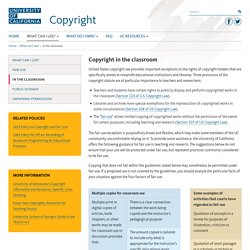
Three provisions of the copyright statute are of particular importance to teachers and researchers: Teachers and students have certain rights to publicly display and perform copyrighted works in the classroom (Section 110 of U.S. Copyright Law).Libraries and archives have special exemptions for the reproduction of copyrighted works in some circumstances (Section 108 of US Copyright Law).The "fair use" allows limited copying of copyrighted works without the permission of the owner for certain purposes, including teaching and research (Section 107 of US Copyright Law). The fair use exception is purposefully broad and flexible, which may make some members of the UC community uncomfortable relying on it. Copying that does not fall within the guidelines stated below may nonetheless be permitted under fair use. Exceptions & Limitations: Classroom Use, Fair Use, and more. If copyright gave creators the ability to completely control all uses of their works, creativity and culture would soon grind to a halt.
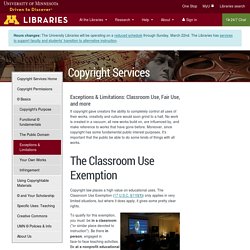
No work is created in a vacuum; all new works build on, are influenced by, and make reference to works that have gone before. Moreover, since copyright has some fundamental public interest purposes, it's important that the public be able to do some kinds of things with all works. Copyright law places a high value on educational uses. The Educator's Guide to Copyright and Fair Use. A five-part series When it comes to copyright law and the application of fair use exceptions, ignorance is definitely not bliss! Learn how to educate yourselves and your students and avoid making a costly mistake! You really did plan to find time over the summer to familiarize yourself with the latest information on copyright law. You absolutely intended to look up the fair use guidelines for using technology resources.
Fair Use in a Nutshell. Fair Use in a Nutshell: A Practical Guide to Fair Use By Attorney Lloyd J.
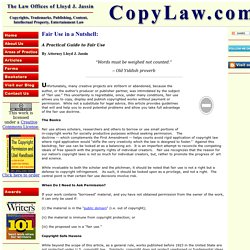
Jassin “Words must be weighed not counted.” -- Old Yiddish proverb Unfortunately, many creative projects are stillborn or abandoned, because the author, or the author's producer or publisher partner, was intimidated by the subject of “fair use.” The Basics Fair use allows scholars, researchers and others to borrow or use small portions of in-copyright works for socially productive purposes without seeking permission. While invaluable to both the scholar and the pitchman, it should be noted that fair use is not a right but a defense to copyright infringement. When Do I Need to Ask Permission? If your work contains "borrowed" material, and you have not obtained permission from the owner of the work, it can only be used if: (i) the material is in the "public domain" (i.e. out of copyright); (ii) the material is immune from copyright protection; or.
Measuring Fair Use: The Four Factors. Unfortunately, the only way to get a definitive answer on whether a particular use is a fair use is to have it resolved in federal court. Judges use four factors to resolve fair use disputes, as discussed in detail below. It’s important to understand that these factors are only guidelines that courts are free to adapt to particular situations on a case‑by‑case basis. In other words, a judge has a great deal of freedom when making a fair use determination, so the outcome in any given case can be hard to predict. The four factors judges consider are: the purpose and character of your usethe nature of the copyrighted workthe amount and substantiality of the portion taken, andthe effect of the use upon the potential market.
How To Legally Use Copyrighted Music, Games, and Movies on YouTube. Introduction to Intellectual Property: Crash Course IP 1. Creative Commons Kiwi. Copyright and Fair Use Animation. 14 copyright essentials teachers and students must know. Using copyrighted material incorrectly can land teachers and students in hot water.

Here’s what you need to know to stay safe. (Image by Gerd Altmann via Pixabay.com / CC0) Students and teachers toe a very fuzzy ethical line every day — many without even realizing it. Some end up on the safe side of the line, but others cross the line and cross ethical boundaries — and sometimes costly legal ones. That line is the copyright line, deciding how teachers and students can respect people’s intellectual property. The bottom line is this: Copyright doesn’t automatically mean, “This is mine. The silver lining is this: Copyright isn’t the only license on digital media. Kristina Peters, a digital learning specialist for the Nebraska Department of Education, recently discussed copyright, licensing and the essentials that teachers and students should know. Here are some of the take-aways from that discussion: 1. 2. 3. 4. 5. 6. 7. 8. 9. 10. 11. Copyright Kids!
Why teach copyright to students? There are several reasons why it is important for students to develop a basic understanding of how copyright and limitations such as fair use work together to encourage creativity.
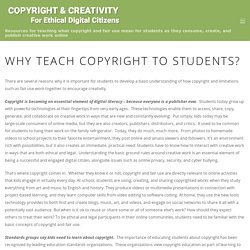
Copyright is becoming an essential element of digital literacy – because everyone is a publisher now. Students today grow up with powerful technologies at their fingertips from very early ages. These technologies enable them to access, share, copy, generate, and collaborate on creative work in ways that are new and constantly evolving. Rutgers University Libraries. Copyright underlies our daily activity at the university- whether we realize it or not.
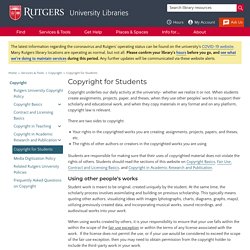
When students create assignments, projects, paper, and theses, when they use other peoples’ works to support their scholarly and educational work, and when they copy materials in any format and on any platform, copyright law is relevant. There are two sides to copyright: Your rights in the copyrighted works you are creating: assignments, projects, papers, and theses, etc.The rights of other authors or creators in the copyrighted works you are using. Students are responsible for making sure that their uses of copyrighted material does not violate the rights of others. Students and Copyright. | Next Page What is copyright?
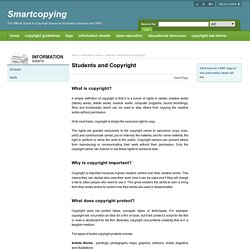
A simple definition of copyright is that it is a bunch of rights in certain creative works (literary works, artistic works, musical works, computer programs, sound recordings, films and broadcasts) which can be used to stop others from copying the creative works without permission.